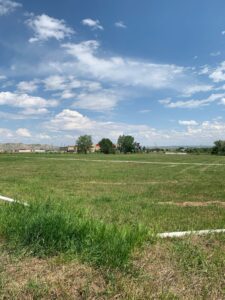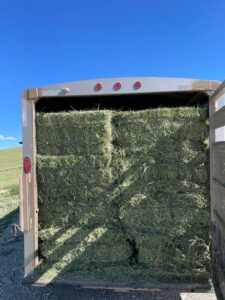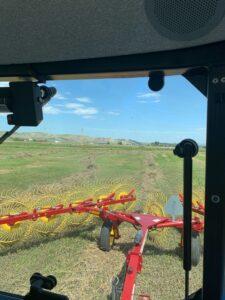Brainstorming A New Approach
#bfrdpwy #aginternship #RightRisk

Having a mix of harvesting, maintenance, horse care, water management, and planning this week made it fly by. Some highlights over the week were getting to run the windrower, finishing laying out irrigation pipe in our Alfalfa Bench pasture and getting roughly 1,300 bales of hay laid. This week I was able to learn more about how yearly calculations are done to make sure profits are marginally ideal. Being able to work with the wranglers, and a couple of volunteers, was a massive help with getting more urgent projects (removing and repairing pipes, filling trailers and baling) completed. I also learned more about how to look at the lifespans of machinery. It was clarified that when it comes to farm equipment, they’re measured by hours, maintenance records, and if applicable, previous ownerships.

I think one of the biggest challenges we have been facing in July is trying to make all of our time as effective as possible right now. Especially, considering this season there has been a lacking crew and heavy machinery operators. I believe that this is something that affects a large majority of agriculture producers in different nuances. The current problem we are being faced with is having one to two people drawing out completely from the season, and not having enough people who are trusted to drive loads of hay up, and more importantly, back down the wind river mountains. Having bales stay laid out in fields also affects when we can begin to irrigate again, the hay quality and accessibility, and stock losses.

My idea with this current dilemma, especially with how many hay rows we have, is to have at minimum three to four days designated solely on making back-to-back trips with at least two trailers. Doing this will not only allow us to be able to get hay stored and off the lower ranch but it will also provide time for merging rows and allowing bales to dry. Each trailer carries, on average, 116 bales and so far, it seems that only about eight or nine trips have been made since baling began. If it can manage to be done, it would allow for a better position at both ranches as August, the busiest time at the upper ranch, begins. Having a better basis to dive into at both locations, getting irrigation running in full swing, and providing lower need for ‘switch-back’ trips would all be benefits from this approach.

Moving forward, there are still some major areas of this operation that I have little knowledge of. I can now say I feel confident in crop production, machinery maintenance and operations, communications, horse and mule handling, basic ‘doctoring’ practices, woodworking, weeding practices, pasture rotations, and range management. Learning so many skills has been amazing, but at the same time I am also curious how heavily laws and associations burden or save farms and ranches. Hearing more about incentives, restrictions, and regulations as a whole is an ocean of information that I’d be eager to dip into. I still would really value being able to know more about how such a large outfit is managed strictly in a business aspect.
Going into my second to last week here, I really hope to be able to finish rounding out my experience here. I hope that an opportunity for me to shadow Mary can come to fruition. I believe a lot of questions would get answered from her point of view. Also, hopefully having the possibility to begin irrigating more fields would be great. Moving into our west pastures, haying-wise, would also be something that will begin soon. Along with hopefully being able to run over the Alfalfa Bench field and irrigate in a second rotation there. Lastly, I also plan to monitor our water sources in case of flooding on top of doing some more weeding.
Submitted by: Olivia Halter
Edits by: GrowinG Internship Team

